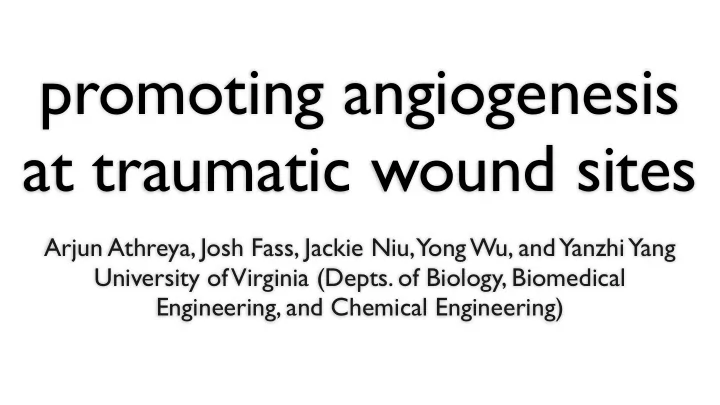

promoting angiogenesis at traumatic wound sites Arjun Athreya, Josh Fass, Jackie Niu, Yong Wu, and Yanzhi Yang University of Virginia (Depts. of Biology, Biomedical Engineering, and Chemical Engineering)
overview • problem • circuit design • how wounds heal • findings and contributions • limitations of • human practices previous approaches • our synthetic biology approach
the problem • 6.5 million US patients suffer from chronic wounds • aerobic organisms contaminate 98% of chronic wounds • most benign, some beneficial • time increases risk of infection Image: www.biooncology.com/research-education/vegf/images/img-pathologic-angiogenesis.jpg
inflamation macrophages predominant 50% strength fibroplasia and granulation tissue formation maturation and remodeling angiogenesis epithelialization contraction years minutes hours days weeks the wound-healing process
angiogenesis cascade oxygen inavailability HIF (hypoxia inducible factor) VEGF kickstarts endothelial (vascular endothelial tissue and mural cell growth growth factor) PDGF- β sustains growth (platelet-derived growth factor) by recruiting pericytes angiogenesis
previous approaches • Natural approach • Slow repair mechanism • Single factor exposure • No sequential release • Tissue engineering approach • Simple release kinetics
tissue engineering approach • Biodegradable polymer scaffolds inserted at wound sites • Scaffolds seeded with functional cells and growth factors • Growth factors encapsulated in scaffold and released upon degradation (Images: Richardson et al. 2001)
biodegradable scaffold release dynamics cannot tune complex c a n Scaffold VEGF n o t n output kinetics s too slow a y t n u c r a t l o c a s c a d e (Images: Richardson et al. 2001)
our synthetic biology approach • Cost-effective bio-machine capable of inducing timely growth of vasculature • Engineer yeast at traumatic wound site • Design genetic circuit that produces optimal rates of HIF- linked growth factor expression without over-shooting target expression • Compatible with the tissue engineering method • Can be seeded into scaffold
galactose* Gal 1/10 LuxR VEGF Bidirectional Promoter dimer LuxI siRNA LuxR PDGF- β yeast cell environment
circuit design BIDIRECTIONAL VEGF PROMOTER LuxR growth factor induced by galactose instead of HIF LuxI translational RA dimer formed by silencing LuxI and LuxR siRNA LuxR PDGF- β growth factor
plasmid map
predicted output dynamics
gibson assembly http://j5.jbei.org/j5manual/pages/22.html
polymerase cycling assembly single stranded 60mers 20bp overlap 5’ 3’ 3’ 5’ oligos bind through subsequent PCR steps
final constructs 100bp 1000bp ladder ladder PDGF - β shuttle vector
final constructs amplified purified 400bp ladder VEGF
main contributions • Submitted 3 parts to Parts Registry • PDGF- β • siRNA for translational inhibition of VEGF • Biobrick-compatible yeast shuttle vector • Predicted behavior of overall circuit
composite coding region for PDGF- β in yeast (BBa_K635001) • Platelet derived growth factor (PDGF) sequence optimized for yeast expression • Biobrick Kozak sequence BBa_J63003. • Random buffer sequence complementary to an siRNA inhibitor designed for modular inhibition of translation in yeast • Poly-A tail prevents degradation of the mRNA fragment • Biobrick BBa_K392003 yeast transcriptional terminator
SI RNA gene silencer for use in yeast (BBa_K635000) • Modular inhibition of translation in yeast • Reverse complementary to the biobrick Kozak sequence BBa_J63003 and a randomly generated buffer sequence that should precede it • Similar to the RSID system developed by the Stanford 2010 iGEM team for siRNA control in E.coli
yeast shuttle vector ( Ura3 & AmpR ) (BBa_K635002) • Biobrick compatible version of a working pRS316 plasmid • Easy-to-use artificial yeast shuttle vector • Auxotrophic uracil selection for yeast expression • Ampicillin selection for E.coli • Kpn1 and Sac1 restriction sites flank prefix, suffix • Yeast transformants selected in a medium lacking uracil • E. coli transformants selected using ampicillin resistance and screened using the RFP promoter
S. cerevisiae (left) Colonies shown are successful yeast transformants using our backbone and BBa_J04450 (which cannot be be expressed as assembled in yeast). Colonies were selected using a medium lacking uracil. E. coli (right) Red transformants indicate successful assembly of the backbone with the registry part BBa_J04450, which contains an RFP reporter protein. The bacterial colonies were selected using ampicillin resistance and screened using the RFP reporter.
next steps • Yeast cell only a convenient first-stage chassis • Clinically, will opt for stem cells or monocytes to avoid immune response • Characterize and tune output of control mechanisms • Clinical testing http://www.stemcellresearchprosandcons101.com/
human practices • Published a research document on our wiki exploring how the patent system can hinder the progress of fields like synthetic biology • Outlines a new approach to promoting innovation for the public good • Reforms: prevent USPTO-FDA regulatory abuse, research exemption, prosecute NPEs • Alternatives: reward system, direct subsidization, commons based peer production
conclusions • A novel approach to accelerating wound-healing • Linked VEGF and PDGF- β to the natural cascade of HIF • Designed and predicted the behavior of circuit • Contributed three fundamentally important parts to the Registry • composite coding region for PDGF- β • siRNA gene silencer • Biobrick-compatible yeast shuttle vector
special thanks • Advisors • Keith Kozminski, Ph.D. • Inchan Kwon, Ph.D. • Jason Papin, Ph. D. • Collaborators • Virginia Commonwealth University • Sponsors • University of Virginia College of Arts & Sciences • UVA Medical School • UVA School of Engineering and Applied Science Alumni Lacey Fund • UVA Office of the Vice President for Research
circuit design BIDIRECTIONAL VEGF PROMOTER LuxR growth factor induced by galactose instead of HIF LuxI translational RA dimer formed by silencing LuxI and LuxR siRNA LuxR PDGF- β growth factor
modeling equations
design justifications • Chassis: Yeast • Molecular machinery complex enough to assemble mammalian genes • Ease of handling (quick culture, BSL 1, advisor expertise) • Contribute to registry • Assembly method: PCA • Gibson failed, single-stranded DNA • Circuit design • Single cell vs intercellular • GAL 1/10 vs HIF-inducible bidirectional promoter
Recommend
More recommend